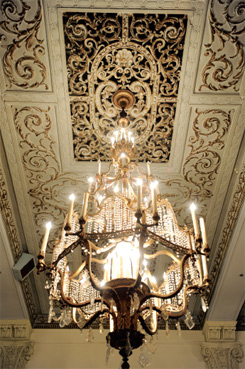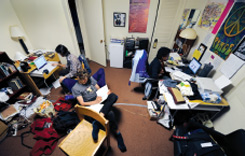Hallowed Hall
Its school days may be numbered, but the Shoreland isn’t resting yet.
By Benjamin Recchie, AB’03
Photography by Dan Dry
The Shoreland is dead. Long live the Shoreland.
Well, not quite dead, but the end is near. Shoreland Hall, the hotel-turned-dormitory that has housed Chicago students for more than 30 years, closes at the end of the current academic year. Many of the 700-odd students who live there will move to the new South Campus Residence Hall at 61st Street and Ellis Avenue, just behind Burton-Judson, joined by a batch of incoming first-years. Several of the houses will move too, though a few will be consolidated.
Built as the Shoreland Hotel in 1926, when Chicago’s south lakefront was a resort destination, the building was famous for its opulence and for some of the guests it drew. Al Capone infamously took up residence for a while; the hotel’s old card room, now a multipurpose space, is informally dubbed the “Capone Card Room” by students today. When Jimmy Hoffa stayed there in the 1950s, it’s rumored, one of his underlings strangled a hotel worker in the lobby for having the temerity to ask Hoffa to pay his bill. Less infamously, Amelia Earhart was feted in the building’s Crystal Ballroom in 1928, and Elvis Presley later stayed there too.
By the 1970s, though, the building was in noticeable decline. Seeking to kill two birds with one stone—refurbish a highly visible neighborhood eyesore and acquire adequate quarters for its burgeoning student population—the University of Chicago bought the building in 1976. Refitted and renamed Shoreland Hall, it became the University’s largest single dormitory. Unusually, a handful of people who had taken up permanent residence in the building while it was still a hotel were allowed to stay as long as they wished; the last non-University residents remained until the 1980s.
Undergraduates enjoyed the building’s colorful history, proximity to the lake, and its easy access to transportation to downtown. (“If you live in the Shoreland,” said second-year Maria Valdes, “you definitely get out more.”) Staff who lived in the Shoreland found other positives about their home: cooking writer and TV chef Alma Lach, who was a resident master from 1978 to 1981, convinced the University to install a gourmet kitchen in her apartment. The Shoreland’s location in east Hyde Park gave students easy access to shopping and transportation downtown. But it was never an ideal dormitory; besides being more than a mile from the main quads, it had been in constant use for 80 years, and time was taking its toll. The University determined in 2004 that rehabilitating the building for another 50 years of dormitory use would be prohibitively expensive, and so opted to plan a new residence hall closer to campus.
But while this is the end of Shoreland the dormitory, it is a new lease on life for Shoreland the structure. Placed on the National Register of Historic Places in 1986, the building is too valuable to demolish or abandon. In 2004 the University sold the Shoreland to a private investor on the condition that it could remain a dormitory until the new residence hall was built. The initial plan was to develop the building as condominiums; several property sales and one housing market collapse later, the Shoreland is slated to be reopened as an apartment building. Before that happens, we wanted to capture its glory days as the center of life for hundreds of College students.


